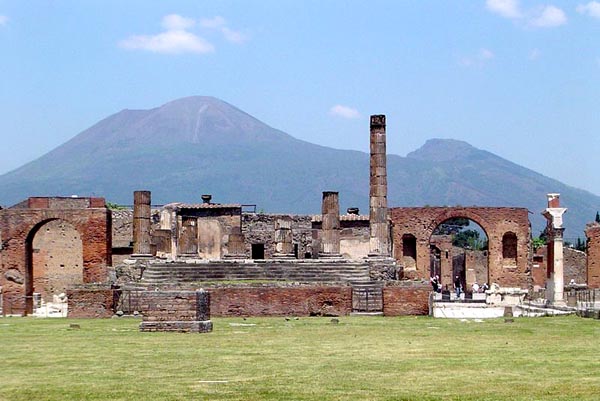 |
| Fresco from the Villa dei Misteri in Pompeii (Wikipedia) |
Note: The eruption that killed Pliny also destroyed several towns, incidentally preserving their art for us to enjoy today.
Get Ready: Are you very familiar with the collection of a particular museum? If so, which one? If not, is there one you would like to visit repeatedly?
In 1974, the year after I graduated from high school, a unique museum opened near the sea in Los Angeles. Now called the Getty Villa, it is mostly a recreation of a house that had been buried in Herculaneum, a seaside town near Pompeii, not far from the city of Naples, Italy. These towns were buried by the eruption of Mount Vesuvius in 79 CE. Today, the Getty Villa houses one of the world's greatest collections of classical art.
 |
| Pompeii with Mount Vesuvius behind (Wikipedia) |
I have spent hours in this gallery, learning the fascinating story of the architecture around me.
The original of the museum's design, the "House of the Papyri," had been lost on that fateful day late in 79 which also took the life of the naturalist Pliny the Elder (see Lesson #04-025). The life of the towns there was frozen in a moment, and was not rediscovered until 1599, when a few remains were uncovered and then covered up again. These first discoverers did not realize what it was they had found.
Things were not fully brought to light until 1738, when men working for the King of Naples rediscovered Herculaneum. Ten years later, Pompeii was uncovered.
Excavations continued through the 18th and 19th centuries. In addition to the buildings and artwork found, there were unusual spaces in the ash layer which were later understood to be the shapes of the humans who had died there. These were filled with plaster to make casts of these unfortunate people.
Several kinds of art were also frozen in time. Imagine encountering an ancient city exactly as it appeared nearly 2,000 years ago. The architecture included monumental arches, amphitheaters, and the homes of the rich.
There are frescoes here, paintings made in the plaster of walls while it was still fresh. The walls and floors also hold many mosaics. These are images made with small tiles to form a brilliant picture. And of course, there is plenty of statuary and pottery.
Much of the art is of an erotic nature. It seems that wealthy Romans were not too concerned about the sexual morals of today. Much of this was hidden away after the first discovery, and has just now begun to be exhibited in public.
--------Read more: https://en.wikipedia.org/wiki/Pompeian_Styles
Practice: Match the term to its definition below:
- amphitheaters
- ash
- erotic
- eruption
- excavations
- gallery
- morals
- plaster
- recreation
- seaside
- a place to exhibit art
- ideas of right and wrong
- digging activities
- of a sexual nature
- the material left after something burns, like the end of a cigarette
- half-round buildings (sometimes outdoors) for viewing performances
- reproduction; copy
- explosion, as of a volcano
- next to the ocean
- a soft material applied to walls, which hardens to protect them; can also be used to make statues
Answers are in the first comment below.
Submitted to the Shenzhen Daily for June 2, 2015


Answers to the Practice: 1. f; 2. e; 3. d; 4. h; 5. c; 6. a; 7. b; 8. j; 9. g; 10. i
ReplyDelete